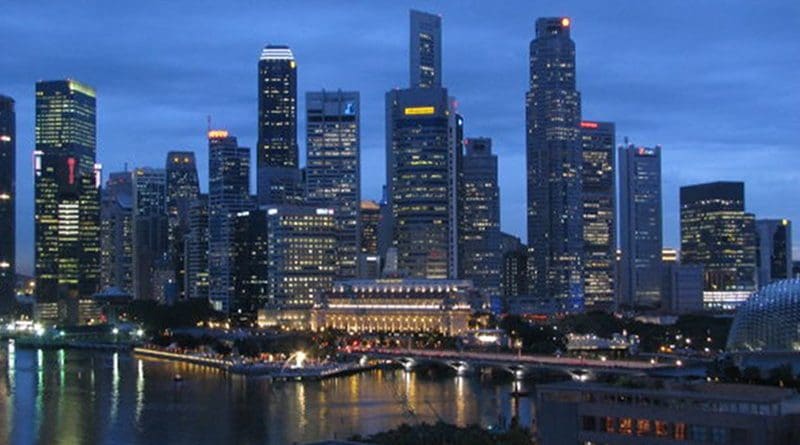The New Drivers Of Asia’s Global Presence – Analysis
This article examines the growing role of Asia in globalization, showing that China is not the only important player and that its impact goes far beyond the economic dimension.
By Mario Esteban*
The pre-eminence of China on the global scene and especially in the economic dimension does not mean that it is the only emerging or Asian country with a consistent participation in the globalization process, or that the internationalisation of the Asian countries is limited to only the economic sphere. Data for the overall region show an upward trend in both military and soft presence. While increasing external presence in Asia’s military domain responds mostly to the figures recorded by Japan and China, Asia’s soft presence is scattered among various countries, with South Korea, Singapore, Thailand and Malaysia all showing increasing shares of soft presence over the 1990-2014 period.
Analysis
Asia and especially China have gained considerably from economic globalization since the end of the Cold War. And economic gain is without a doubt the best known facet of the process of internationalization currently being experienced by most Asian countries.1 In this paper we explore other dimensions, military and soft, where the specific weight of Asia has also grown significantly, demonstrating that Asia is not merely China, and that the region’s growing international presence is not limited to the economic sphere.
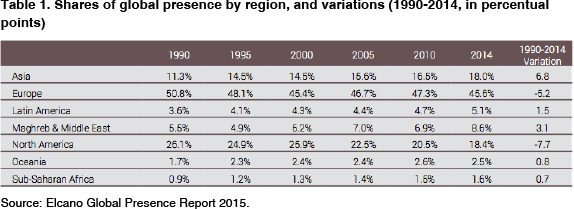 When analyzing the evolution since 1990 of shares of global presence by region, one notes both the decline of the traditional powers, Europe and the US, as well as the emergence of Asia (Table 1). In fact, the increase in the Asian presence is greater than the sum of the increased shares of all other regions that experienced expansion in that period. These developments point towards Asia soon overtaking America as the region with the second-largest share of global presence. In 2010, the US share of 20.5% was four points higher than Asia’s 16.5%. Four years later, the gap had narrowed to just four tenths of a percent: 18.4% versus 18.0%.
When analyzing the evolution since 1990 of shares of global presence by region, one notes both the decline of the traditional powers, Europe and the US, as well as the emergence of Asia (Table 1). In fact, the increase in the Asian presence is greater than the sum of the increased shares of all other regions that experienced expansion in that period. These developments point towards Asia soon overtaking America as the region with the second-largest share of global presence. In 2010, the US share of 20.5% was four points higher than Asia’s 16.5%. Four years later, the gap had narrowed to just four tenths of a percent: 18.4% versus 18.0%.
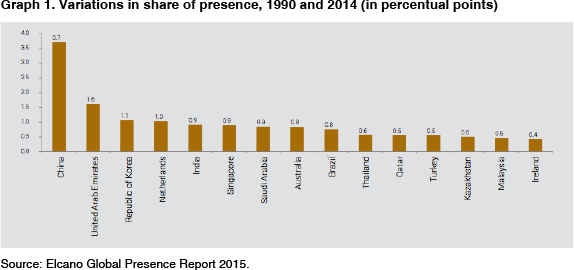 If we look at the ranking of countries that have increased their global presence since 1990 we can confirm the notion that China is mainly responsible for the dramatic increases in the share of Asian presence (Graph 1). Not surprisingly, China is the country whose share of global presence has grown most over the past quarter of a century. The Asian giant has increased its share by 3.7 points, equivalent to the sum of the current shares of global presence of Japan and Iceland.
If we look at the ranking of countries that have increased their global presence since 1990 we can confirm the notion that China is mainly responsible for the dramatic increases in the share of Asian presence (Graph 1). Not surprisingly, China is the country whose share of global presence has grown most over the past quarter of a century. The Asian giant has increased its share by 3.7 points, equivalent to the sum of the current shares of global presence of Japan and Iceland.
The significant growth in China’s global presence currently accounts for 28.5% of the overall Asian share, versus only 12.6% in 1990. This increase in the specific weight of China’s share of Asia’s global presence has come largely at the expense of a declining Japanese presence (Graph 2). Nevertheless, China remains far from garnering the percentage share of Asian presence commanded by Japan in 1990, at about 42.7%.
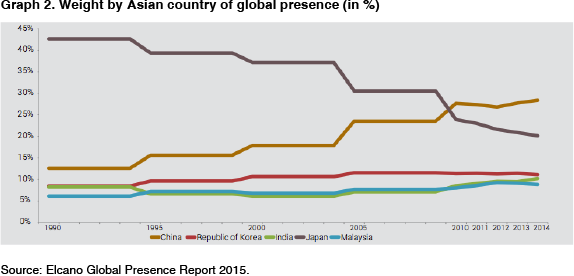 However, this should not blind us to the meaningful advances made by other Asian countries. Indeed, China accounts for less than 50% of the positive gains in presence experienced in the region. Among the 10 countries that have raised their share of global presence, excluding China, four are Asian: South Korea, India, Singapore and Thailand. If we expand that range to the top 15, Malaysia also appears. If we combine the increased share in presence of those five Asian countries we obtain a rise of 4.0 percentage points, three tenths of a percent above China’s 3.7 points. As for the Asian countries that have lost shares of global presence since 1990, there are only two, Japan and Pakistan. The case of Japan corresponds to a traditional pattern experienced by post-industrial powers, mitigated by its rise in military presence. As for Pakistan, the main factor since the 1990s has been the decline in the country’s number of international migrants, mainly Afghan refugees.
However, this should not blind us to the meaningful advances made by other Asian countries. Indeed, China accounts for less than 50% of the positive gains in presence experienced in the region. Among the 10 countries that have raised their share of global presence, excluding China, four are Asian: South Korea, India, Singapore and Thailand. If we expand that range to the top 15, Malaysia also appears. If we combine the increased share in presence of those five Asian countries we obtain a rise of 4.0 percentage points, three tenths of a percent above China’s 3.7 points. As for the Asian countries that have lost shares of global presence since 1990, there are only two, Japan and Pakistan. The case of Japan corresponds to a traditional pattern experienced by post-industrial powers, mitigated by its rise in military presence. As for Pakistan, the main factor since the 1990s has been the decline in the country’s number of international migrants, mainly Afghan refugees.
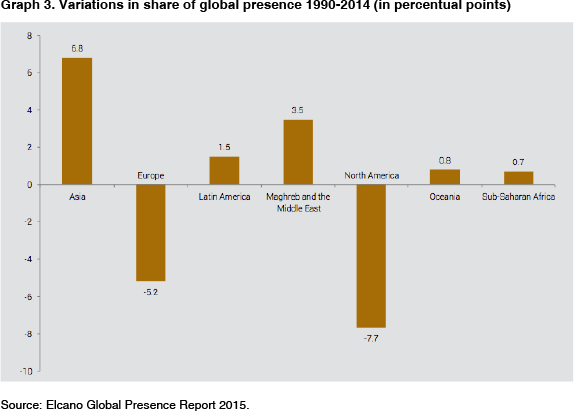 In analyzing the evolution of the shares of Asian global presence (Graph 3), the first thing to stand out is that it is the region that has most increased its share in the economic as well as in the military and soft dimensions. Furthermore, it has been the military and not economic dimension that has gained most (10.9 versus 5.9 points, respectively).
In analyzing the evolution of the shares of Asian global presence (Graph 3), the first thing to stand out is that it is the region that has most increased its share in the economic as well as in the military and soft dimensions. Furthermore, it has been the military and not economic dimension that has gained most (10.9 versus 5.9 points, respectively).
Moreover, since 2011, shares of Asian military and soft presence, at 3.3 and 0.5 points, respectively, have been outpacing the region’s share of economic presence, which has remained stagnant (Graph 4). That is to say, the share of Asia’s global presence is currently growing thanks to the military and soft dimensions, which have not been restrained by the concurrent slowdown in Asia’s economic internationalisation.
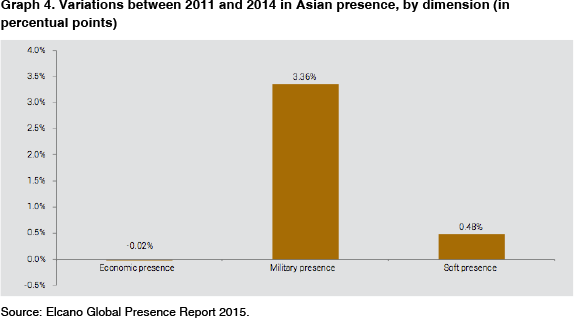 The rise of Asia’s military presence is striking. Considering the rankings of the 15 countries that have increased their military presence since 1990 (Graph 5), there are three Asian nations within the top four (China, Japan, and India), seven in the top 10 (adding Korea, Indonesia, Pakistan and Singapore) and at positions 11 and 13 two more Asian countries, Bangladesh and Thailand.
The rise of Asia’s military presence is striking. Considering the rankings of the 15 countries that have increased their military presence since 1990 (Graph 5), there are three Asian nations within the top four (China, Japan, and India), seven in the top 10 (adding Korea, Indonesia, Pakistan and Singapore) and at positions 11 and 13 two more Asian countries, Bangladesh and Thailand.
Moreover, occupying the 1st and 12th positions are the US and Australia; not Asian, but very closely involved in security dynamics throughout the region.
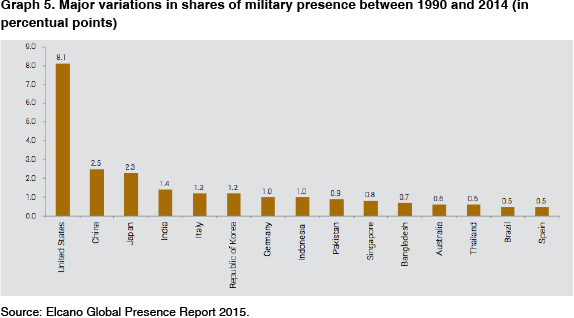 Comparing how Asian states are positioned within different presence rankings (Table 2), there appears to be tendency by these countries to project themselves into the military sphere.
Comparing how Asian states are positioned within different presence rankings (Table 2), there appears to be tendency by these countries to project themselves into the military sphere.
Of the 13 Asian countries under analysis, six have a military presence that is much higher than might be expected based on their levels of global presence: Bangladesh, Pakistan, Sri Lanka, Indonesia, the Philippines and India. Meanwhile, the military presence of two others, South Korea and Thailand, is moderately above their rankings of global presence, while three show a relative balance between military presence and other dimensions (China, Japan and Singapore). Only two Asian countries (Malaysia and Vietnam) show levels of military presence moderately below their global presence ranking.
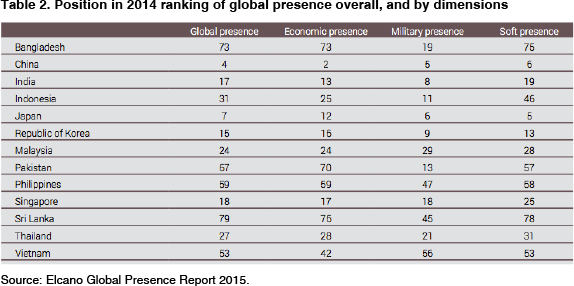 The data from this latest edition of the Elcano Global Presence Index confirm the continuation of the trend in which Asian countries augment their military presence; of the three presence dimensions, this is the only area in which no Asian country has lost ground in its ranking since the previous year (Table 3).
The data from this latest edition of the Elcano Global Presence Index confirm the continuation of the trend in which Asian countries augment their military presence; of the three presence dimensions, this is the only area in which no Asian country has lost ground in its ranking since the previous year (Table 3).
Indeed, of the 13 Asian countries included in the index this year, seven have improved their position in the military presence ranking: Malaysia, South Korea, Indonesia, Sri Lanka, Bangladesh, Pakistan and the Philippines. Of the 15 countries that have most increased their military presence in 2013-14, four were Asian: South Korea, India, Singapore and Sri Lanka.
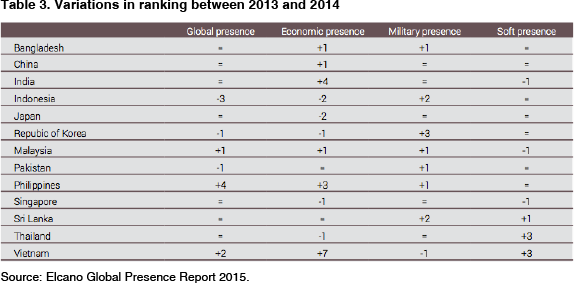 There are two interrelated processes that explain most of the increased military presence in Asia: the normalisation of the Japan Self-Defence Forces and the modernisation of the People’s Liberation Army in China. As a result of Japan’s defeat in World War II, the country’s armed forces have undergone major constraints in their abilities to project force and to deploy troops outside Japanese territory. These limitations have gradually become milder since the early 1990s and the current government is expected to move with greater urgency in the years to come, as indicated by the National Security Strategy adopted in December 2013. The process has led Japan to become the nation that has most increased its military presence in absolute terms between 1990 and 2014, and the trend has accelerated very noticeably in recent years, in response to the modernisation of the Chinese army. China, in turn, is the 2nd-ranked country in terms of increased military presence in absolute terms since 1990, and this has triggered reactions similar to the Japanese in China’s other neighbouring countries. Such measures are understandable since Asia is a region with numerous open international conflicts while at the same time lacking effective security solutions; still, one has to wonder at the future implications of this phenomenon.
There are two interrelated processes that explain most of the increased military presence in Asia: the normalisation of the Japan Self-Defence Forces and the modernisation of the People’s Liberation Army in China. As a result of Japan’s defeat in World War II, the country’s armed forces have undergone major constraints in their abilities to project force and to deploy troops outside Japanese territory. These limitations have gradually become milder since the early 1990s and the current government is expected to move with greater urgency in the years to come, as indicated by the National Security Strategy adopted in December 2013. The process has led Japan to become the nation that has most increased its military presence in absolute terms between 1990 and 2014, and the trend has accelerated very noticeably in recent years, in response to the modernisation of the Chinese army. China, in turn, is the 2nd-ranked country in terms of increased military presence in absolute terms since 1990, and this has triggered reactions similar to the Japanese in China’s other neighbouring countries. Such measures are understandable since Asia is a region with numerous open international conflicts while at the same time lacking effective security solutions; still, one has to wonder at the future implications of this phenomenon.
In considering Asia’s growing international military presence, there are two competing interpretations. Some call it an arms race, a dangerous process of competition that could result in a militaristic spiral of uncertain outcome. Others posit a more benign interpretation and consider the increase in Asian military presence a sign of greater commitment (by several of the region’s countries) to the maintenance of international peace, whether in the interests of advanced economic internationalisation or out of a desire to enhance their status within the international community.
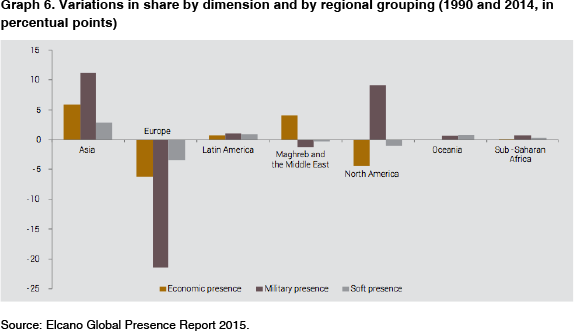 The data collected by the Elcano Global Presence Index for the period 1990-2014 suggest an ambivalent interpretation. At one extreme we find Bangladesh, India and Pakistan, which have dramatically increased their contribution of troops to UN peacekeeping missions while reducing or only slightly increasing their means of military projection. China and Indonesia, meanwhile, are countries that currently contribute many more international peacekeeping forces than in the past, but which have also significantly increased their capability for military projection (especially China). Elsewhere, South Korea and Japan have both increased their contributions to UN peacekeeping missions, but not nearly as much as they have augmented their means of force projection. Finally, Singapore contributes no peacekeeping troops at all, and Thailand very few, for UN missions, despite having strongly increased their means of military projection throughout the period. In other words, with few exceptions, the expansion and modernisation of the means of military projection in Asia have ranked above the commitment of these countries to participate in international peace missions.
The data collected by the Elcano Global Presence Index for the period 1990-2014 suggest an ambivalent interpretation. At one extreme we find Bangladesh, India and Pakistan, which have dramatically increased their contribution of troops to UN peacekeeping missions while reducing or only slightly increasing their means of military projection. China and Indonesia, meanwhile, are countries that currently contribute many more international peacekeeping forces than in the past, but which have also significantly increased their capability for military projection (especially China). Elsewhere, South Korea and Japan have both increased their contributions to UN peacekeeping missions, but not nearly as much as they have augmented their means of force projection. Finally, Singapore contributes no peacekeeping troops at all, and Thailand very few, for UN missions, despite having strongly increased their means of military projection throughout the period. In other words, with few exceptions, the expansion and modernisation of the means of military projection in Asia have ranked above the commitment of these countries to participate in international peace missions.
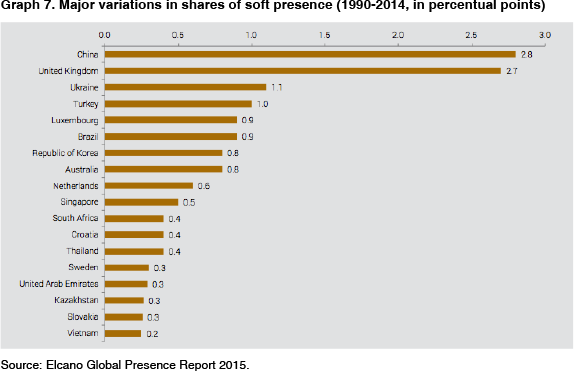 As regards soft presence, the evolution of share by region (Graph 6) has been much smoother than in the cases of economic and military presence. Hence, although Asia has increased its share of soft presence overall, it accounts for only 2.8 points. The country that has most increased its share of soft presence worldwide between 1990 and 2014 is China, with 2.8 points; South Korea ranks in 7th place with 0.8 points; and three other Asian countries fall within the first 15 positions: Singapore, Thailand and Vietnam (Graph 7).
As regards soft presence, the evolution of share by region (Graph 6) has been much smoother than in the cases of economic and military presence. Hence, although Asia has increased its share of soft presence overall, it accounts for only 2.8 points. The country that has most increased its share of soft presence worldwide between 1990 and 2014 is China, with 2.8 points; South Korea ranks in 7th place with 0.8 points; and three other Asian countries fall within the first 15 positions: Singapore, Thailand and Vietnam (Graph 7).
Observing the absolute variations of soft presence for the past year (Graph 8), three Asian countries are among the top 10: Japan, China and Thailand, with Japan and Thailand increasing their shares over the previous year by one tenth of a percent. China and Thailand were both ranked in this group by the previous edition of Elcano Global Presence Index. Japan, due to sharp cuts to its international cooperation budget, was the only Asian country to show an absolute decline in international soft presence between 2012 and 2013; but the trend has been reversed and it is precisely the strengthening of development cooperation that explains most of the country’s subsequent growth in soft presence between 2013 and 2014.
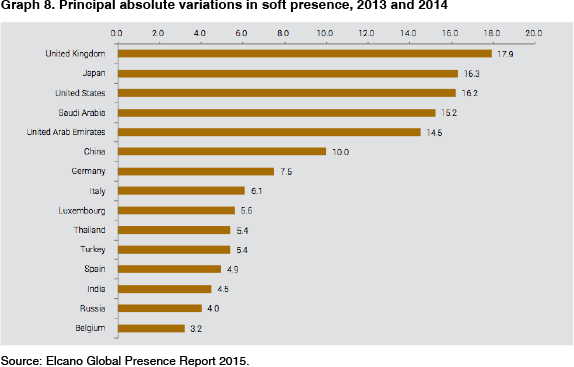 By identifying the variables underlying the rise of the soft presence of Asian countries, it can be seen that tourism is as a near-constant in the countries that have increased their share. Moreover, the South-East Asian countries (excepting Singapore and Malaysia) can be said to be almost exclusively responsible for the increase in the continent’s overall soft presence. In countries such as China, South Korea and India, plus Singapore and Malaysia, tourism does not have an especially strong impact or its soft presence is complemented by other variables including science, culture and education. Also striking is that, with the exception of India, South Asia generally shows a stagnant or declining share of soft presence, because these countries have not boosted tourism like their South-East Asian neighbors and because they have considerably lower levels of socioeconomic development, which hampers the positive development of other variables.
By identifying the variables underlying the rise of the soft presence of Asian countries, it can be seen that tourism is as a near-constant in the countries that have increased their share. Moreover, the South-East Asian countries (excepting Singapore and Malaysia) can be said to be almost exclusively responsible for the increase in the continent’s overall soft presence. In countries such as China, South Korea and India, plus Singapore and Malaysia, tourism does not have an especially strong impact or its soft presence is complemented by other variables including science, culture and education. Also striking is that, with the exception of India, South Asia generally shows a stagnant or declining share of soft presence, because these countries have not boosted tourism like their South-East Asian neighbors and because they have considerably lower levels of socioeconomic development, which hampers the positive development of other variables.
Conclusions
It is clear that the growing internationalization of Asia goes beyond China and the economic sphere, the manifestations of the booming Asian presence with which we are most familiar. However, while China does account for an increasing percentage of Asia’s global presence, the share of Asia’s economic presence has stalled since 2011, helping the military and soft dimensions to become the two main sources of its growing share in global presence.
About the author:
*Mario Esteban, Senior Analyst, Elcano Royal Institute | @wizma9
Source:
This article was published by Elcano Royal Institute
Original version in Spanish: Los nuevos motores de la presencia global asiática
Notes:
1 This phenomenon has been recently addressed using data from previous editions of the Elcano Global Presence Index. See Mario Esteban (2014), ‘The Rise of China and Asia: What the Elcano Global Presence Index Tells Us’, ARI, nr 21/2014, Elcano Royal Institute; and Mario Esteban (2014), ‘La globalización de Asia según el Índice Elcano de Presencia Global’, Comentario Elcano, nr 34/2014, Elcano Royal Institute.

